
Research Article
Austin J Surg. 2018; 5(2): 1124.
MINI-OPCABG an Alternative to Hybrid Coronary Revascularization
Federico B*, Vicenzo C and Natalia S
Cardiac Surgery Benetti Foundation, Rosario, Argentina
*Corresponding author: Federico Benetti, Cardiac Surgery Benetti Foundation, Rosario, Argentina
Received: December 12, 2017; Accepted: January 10, 2018; Published: February 08, 2018
Abstract
Hybrid Coronary Revascularization (HCR) combines minimally invasive left internal mammary artery to left anterior descending bypass with percutaneous coronary intervention of non-left anterior descending vessels. The variability in hybrid coronary revascularization techniques makes it difficult to draw firm conclusions from the currently evidences in terms of cost /effective strategy and a technique easy to reproduce , The hybrid strategy using MINI-OPCAB appears to be a promising and cost-effective alternative for CABG in the treatment of multi vessel coronary artery disease.
We describe our initial experience in hybrid coronary revascularization using MINI-OPCAB technique. This operation was described and the follow up results demonstrated. Material and Methods, five patients were stenting after a MINI OPCAB operation. The average age was 69(Ds±4.8ci95%). One patient had Left Main and a Right coronary lesion 3 patients had three vessels disease and 1 two vessel disease; the average SYNTAX score was 35.2(Ds+-8,2ci95%). Three patients received a circumflex and right coronary stenting 1 patient a right and 1 a circumflex coronary stenting.
A result, no thirty-day mortality was reported in these series. All patients completed hybrid procedure and there wasn’t any conversion to full sternotomy. Mean intubation time was 1.5(Ds±3.2hrsCi95%); after the surgical procedure. Length of hospital stay was 2 days (Ds±11 hours ci95%), one patient received 1packed RBC (red blood cells) transfusion, the stenting was done in different time frame from hours to 14 months. During PCI procedure angiographic evaluation of LIMA, grafting was routinely performed and LIMA patency rate was 100%. At tree years follow up. Patient’s freedom from MACCE was 100% after the procedure conclusion. We believe that with MINI-OPCABG can solve these issues. Long term follow-up and randomized multicenter trial comparing one stop hybrid revascularization with MINI-OPCABG with conventional CABG, OPCABG, MIDCABG, TECAB or ROBOTIC will be needed to find the best option for these patients.
Keywords: Hybrid revascularization; MINI OPCAB mammary to Lad and stenting; Minimally invasive coronary surgery; Hybrid revascularization another option
Introduction
Hybrid Coronary Revascularization (HCR) combines minimally invasive left internal mammary artery to left anterior descending bypass with percutaneous coronary intervention of non-left anterior descending vessels. And is feasible and appeared to be safe, with faster recovery and similar outcomes when compared with conventional CABG [1-4]. Also Hybrid coronary revascularization is a viable option to perform a minimally invasive, functionally complete revascularization in high-risk patients instead of conventional revascularization [5] robotic-assisted LITA harvesting and a small left anterior thoracotomy survival, freedom from angina and freedom from revascularization also appear favorable at the 5-year clinical follow-up [6]. Closed chest hybrid revascularization is another although more complex option [7].
The variability in hybrid coronary revascularization techniques makes it difficult to draw firm conclusions from the currently evidences in terms of cost /effective strategy and a technique easy to reproduce , The hybrid strategy using MINI-OPCAB appears to be a promising and cost-effective alternative for CABG in the treatment of multi vessel coronary artery disease.
We describe our initial experience in hybrid coronary revascularization using MINI-OPCAB technique. This operation was described and the follow up results demonstrated [8-11].
Materials and Methods
From 1990 to 2017 58 patients received Hybrid coronary treatment during the same Hospitalization in ours Institutions with different surgical off pump approaches, Sternotomy, Limited no opening Sternotomy, MIDCAB and MINI OPCAB. Five patients were stenting after a MINI OPCAB operation.the average age was 69(Ds±4.8ci95%), 1patient had Left Main and a Right coronary lesion 3 patients had three vessels disease and 1 two vessel disease ; the average SYNTAX score was 35.2 (Ds +-8,2 ci 95%).Three patients received a circumflex and right coronary stenting 1 patient a right and 1 a circumflex coronary stenting.
Surgical technique
A skin incision is made from the xiphoid up to the level between the fourth and third inters costal space. The hemi-sternum is opened and the left table is lifted to dissect the Left Mammary Artery (LIMA) (Figure 1,2) The LIMA was dissected up to the third inter costal space and skeletonized. The angle of the superior part where the LIMA is attached to the sternum needs to be below 20 degrees to avoid any potential kink (Figure 3). The pericardium is open from the left border of the pulmonary artery down to the apex of the heart In most of the cases you see directly the LAD, in this moment you measure the distance of the mammary to avoid any kinking (Figure 4); two stitches about 2 cm deep in the left border of the pericardium are placed with a distance of 5 to 7 cm for better exposure of the Left Anterior Descending (LAD) artery (Figure 5). The retractor is change on the an astomosis is performed with a mechanical stabilizer with the opening part towards the head of the patient to avoid any problem of damaging the graft. The stenting were done in different time frames our actual tendency like in the last patient after the graft in the mammary is done, with the patient sleep we infused from the nasogastric tube, clopidogrel (300 mg) and didn’t revert the Heparin (1,5 mg /KG) control the mammary an astomosis and stenting with the incision open and after finish revert the heparin if it is necessary and the surgical incision is closed.
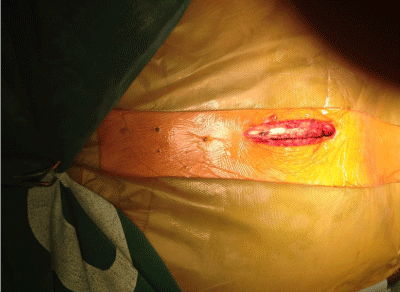
Figure 1:
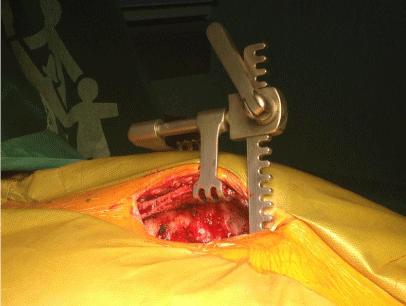
Figure 2:
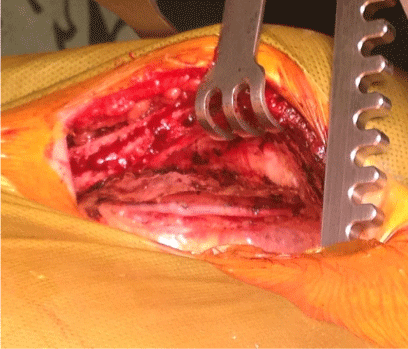
Figure 3:
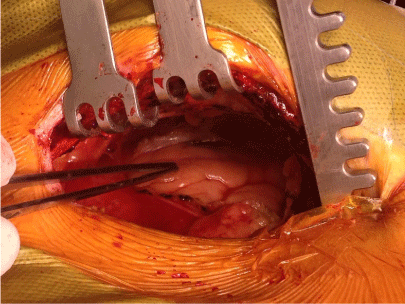
Figure 4:
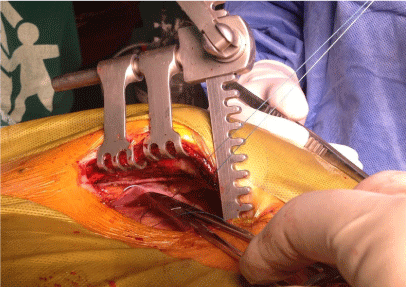
Figure 5:
Results
No thirty-day mortality was reported in these series. All patients completed hybrid procedure and there wasn’t any conversion to full sternotomy. Mean intubation time was 1.5 hrs (D ±3.2ci95%), after the surgical procedure. Length of hospital stay was 2days (D±11 hours ci95%), one patient received 1packed RBC (Red Blood Cells) transfusion, The stenting was done in different time frame from hours to 14 months. During PCI procedure angiographic evaluation of LIMA, grafting was routinely performed and LIMA patency rate was 100%. At one year follow up. Patient’s freedom from MACCE was 100% after the procedure
Conclusion
Hybrid approach has not been widely adopted because practical and logistical concerns have been expressed. These concerns implicate the need for close cooperation between surgeon and interventional cardiologist, logistical issues regarding sequencing and timing of the procedures and the use of aggressive anti platelet therapy for DES can be minimized. We believe that with MINI-OPCABG operation is possible to solve these issues. Long term follow-up and randomized multicenter trial comparing one stop hybrid revascularization with MINI-OPCABG with conventional CABG, OPCABG or MIDCABG, TECAB, ROBOTIC will be needed to find the best option for these patients.
References
- Harskamp RE, Vassiliades TA, Mehta RH, de Winter RJ, Lopes RD, Xian Y, et al. Comparative Effectiveness of Hybrid Coronary Revascularization vs. Coronary Artery Bypass Grafting. J Am Coll Surg. 2015; 221: 326-334 .
- Gasior M, Zembala MO, Tajstra M, Filipiak K, Gierlotka M, Hrapkowicz T, et al. Hybrid revascularization for multi vessel coronary artery disease. Cardiovascular Interventions. 2014; 7: 1277-1283.
- Benetti FJ, Ballester C. Use of thoracoscopy and a minimal thoracotomy, in mammary-coronary bypass to left anterior descending artery, without extracorporeal circulation. Experience in 2 cases. J Cardiovasc Surg. 1995; 36: 159-161.
- Benetti F. Method for coronary bypass. United State Patent Ñ.
- Repossini A, Tespili M, Saino A, Di Bacco L, Giroletti L, Rosati F, et al. Hybrid coronary revascularization in 100 patients with multivessel coronary disease. Ann Thorac Surgery. 2014; 98: 574-580.
- Adams C, Burns DJ, Chu MW, Jones PM, Shridar K, Teefy P, et al. Singlestage hybrid coronary revascularization with long-term follow-up. Eur J Cardiothorac Surg. 2014; 45: 443-442.
- Bonaros N, Schachner T, Wiedemann D, Weidinger F, Lehr E, Zimrin D, et al. Closed chest hybrid coronary revascularization for multivessel disease - current concepts and techniques from a two-center experience. Eur J Cardiothorac Surg. 2011; 40: 783-787.
- Benetti F. Minimally invasive coronary surgery (the xiphoid approach). Eur J Cardiothorac Surg. 1999; 16: S10-S1.
- Benetti FJ, Taylor CS, Morejohn MV. Xyphoid Access for cardiac surgical Procedures. US Patent 6199556B1. 2004.
- Benetti FJ, Ameriso JL, Scialacomo N. Benetti Mini Opcabg System. Chirurgie Thoracique cardio-vasculaire. 2012; 16: 69-71.
- Benetti F, Natalia S, Jose LA, Bruno B. MINI OPCABG. Artery Bypass .2013.